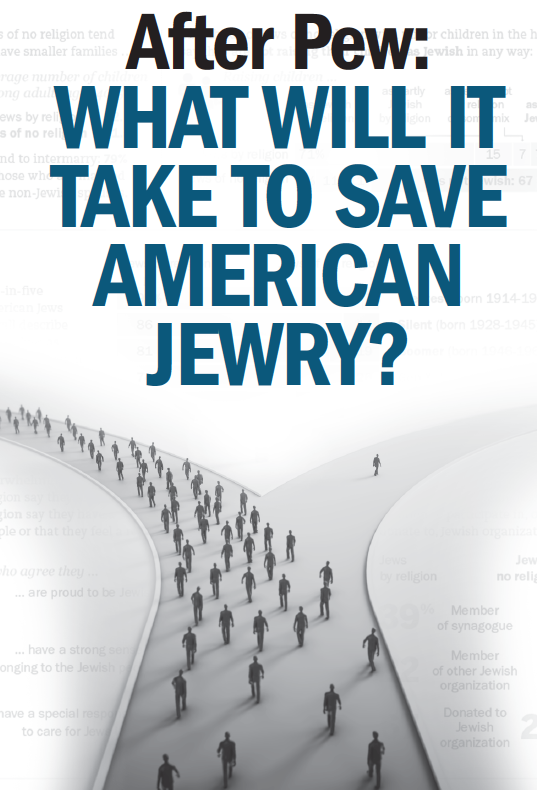After Pew: What Will It Take to Save American Jewry
Taking Our Cue from Pew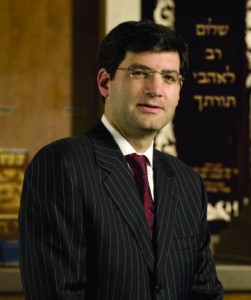
By Steven Weil
Not all of the news coming out of the Pew Research Center’s “A Portrait of Jewish Americans” released this past October is depressing. The Orthodox population is growing exponentially. We have a high birthrate and a very low intermarriage rate.
Moreover, one of the most impressive findings of the Pew report is that 70 percent of the Orthodox population was raised Orthodox. That means that 30 percent, or three out of every ten Orthodox Jews, did not grow up Orthodox but became Orthodox somewhere along the way. Not only is Orthodoxy attracting those from other streams, but our retention rate is remarkably high. It used to be that only 22 percent of American Jews stayed Orthodox. Today, 83 percent of Orthodox Jews stay Orthodox. Although we would prefer to retain 100 percent, no other group in the Jewish community or any other faith community has improved its retention rate like Orthodox Jewry.
No doubt, we have a right to feel proud of our accomplishments, specifically the burgeoning day school movement, the vast array of Orthodox summer camps and programs, phenomenally successful youth groups such as NCSY, the limitless chesed organizations in each and every Orthodox community as well as all of the other communal endeavors that have helped make Orthodoxy strong and vibrant as we enter the twenty-first century. But the truth is that as much as we have accomplished, we haven’t accomplished nearly enough.
Among our non-Orthodox brethren, the intermarriage rate has skyrocketed. If we leave out the Orthodox—who very rarely intermarry—71.5 percent of American Jews marry outside of the faith. (This number refers to no form of conversion, that is, when the spouse identifies him or herself as a non-Jew. If we included nonhalachic conversions, the number is significantly higher.) That statistic should make us all feel deeply distressed. Are we not our brothers’ keepers?
There are significant parallels between the Pew study and the National Jewish Population Study conducted in 2000. Both studies arrive at the same devastating conclusion: the non-Orthodox Jewish population is heading on a path toward becoming a small fraction of itself. As the Pew report made clear, the largest block of American Jews ages forty and under are unaffiliated. Moreover, most non-Orthodox Jews will intermarry; among children of the intermarried, the statistics are abysmal. Only 17 percent of the children of intermarried couples marry other Jews. With a birthrate of only 1.9 children and an astoundingly high intermarriage rate, American Jewry is on a train speeding headlong into self-destruction. This should devastate each and every one of us.
Tragically, this will not be the first time in our history that a segment of our people cut themselves off from the Jewish nation. Following the Assyrian conquest of the Northern Kingdom of Israel in the eighth century BCE, the Ten Tribes were exiled to various lands, and they gradually assimilated and disappeared.
Tragically, this will not be the first time in our history that a segment of our people cut themselves off from the Jewish nation.
The Chumash (Parashat Beshalach 13:18) records that when the Jews left Egypt, “vachamushim alu Bnei Yisrael m’Eretz Mitzrayim, and the Jewish people were armed when they came up from the Land of Egypt.” But Rashi notes that the word “chamushim” does not only mean armed; it also means one-fifth. Rashi asserts that the Torah’s use of this particular word comes to teach us that only one-fifth of the Jewish people in Egypt actually left during the Exodus.
Imagine, during the greatest moments in Jewish history—the Exodus and the ensuing Revelation at Mount Sinai—a full 80 percent of the Jewish nation stayed behind. They shared no part in the historic Yetziat Mitzrayim, no part in the Revelation at Mount Sinai, no part in the destiny of the Jewish nation.
I cannot help but notice disturbing parallels to our situation today. Hashem gave us the miraculous gift of being able to return to our homeland and create a society after two millennia of persecution and dispersion among the nations of the world. At this extraordinary period in history, American Jewry is choosing to not identify with the Jewish people; it is choosing spiritual oblivion.
Throughout America, and indeed, throughout the entire Western World—be it Johannesburg, London, Melbourne or Los Angles—in practically every major city where Jews live, a spiritual holocaust is taking place. We are traumatized by the six million lives lost in the Holocaust, but we are losing more Jews today through indifference and inertia.
Aside from wringing our hands in despair, what can we do?
We must model ethical and moral living.
We can have a profound and lasting influence on our nonreligious brothers and sisters simply by living lives of integrity, decency and honesty—by living genuine Torah lives. We represent the Torah to nonreligious Jews and to the world. As such, the Torah must inform all of the seemingly trivial interactions we have throughout the day. It must guide us in how we conduct our business affairs, how we deal with clients and business associates, how we treat employees and how we pay our creditors.
You may recall Aaron Feuerstein, the CEO of Malden Mills, a textile company in Massachusetts. (His brother Moses was president of the Orthodox Union from 1954 to 1966.) A devastating fire destroyed his factory in 1995, and instead of moving production overseas or taking the insurance money and retiring, Feuerstein insisted on paying his employees while his factory was being rebuilt. The story made national news, and he, an Orthodox Jew, became a symbol of moral leadership. Who knows how many unaffiliated Jews were inspired by his ethical example to rethink their Jewish roots and discover their Torah heritage?
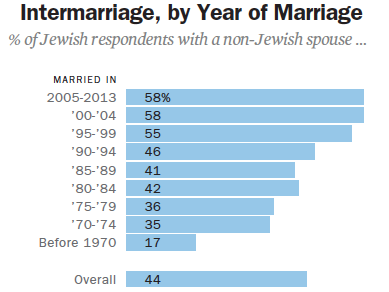
The rate of intermarriage among American Jews is 58%. Excluding the Orthodox, the number is even higher, with up to 71% of Jews marrying out of the faith. In other words, seven out of every ten non-Orthodox Jews intermarry.
*Based on current, intact marriages.
Unless indicated otherwise, all charts and tables courtesy of the Pew Research Center, “A Portrait of Jewish Americans,” October 2013, www.pewforum.org/2013/10/01/jewish-american-beliefs-attitudes-culture-survey/.
Become an ambassador for Orthodoxy.
We cannot afford to relegate kiruv to the professionals. Each and every one of us must get involved. Of course, we must be cognizant of the fact that we will not reach our spiritually estranged brothers and sisters by being condescending or preachy. Our job is to engage and stimulate. We need to open up new vistas; expose nonreligious Jews to the power and depth of Torah. The Torah, it is often noted, sells itself.
Invite your unaffiliated neighbor to share a meal in your sukkah. Bring your nonreligious coworker to your home for Chanukah candle lighting. Give mishloach manot to people who wouldn’t receive them otherwise. (You would be surprised at how great an impression a small bottle of grape juice and a few hamantaschen can make!)
There is no impact on an unaffiliated Jew like experiencing a Friday night dinner with an observant family, where he can be a part of the singing, stimulating discussions, four-course meal and warm camaraderie.
We should all take an example from Hart Levine. Some years ago, Hart was an undergraduate student at the University of Pennsylvania majoring in bioengineering. An Orthodox student, Hart was grateful for the relatively strong Orthodox campus life. But then he noticed something: there were hundreds of Jewish students on campus who were totally uninvolved in Jewish life, who barely knew there was a Hillel on campus. Hart began inviting his fellow Jewish students to join him for Shabbat dinner. He was amazed by the enthusiastic response—some students stayed for hours, refusing to leave. The experience was so different from anything they had ever experienced. They wanted more.
Soon Hart began hosting Sedarim and Shabbatonim. He contacted friends on other campuses and they too began inviting friends to Shabbat dinners, to Chanukah candle lighting ceremonies, to Megillah readings. A grassroots movement was launched—known as Heart2Heart—whose success was based on the most simple ideas: warm peer relationships and intimate Jewish experiences. Heart2Heart, which is today sponsored by the OU, is found on fifty-four campuses throughout the world. We must all become Hart Levines.

One of most impressive findings of the Pew report is that 70 percent of the Orthodox population were raised Orthodox. That means that 30 percent, or three out of every ten Orthodox Jews, did not grow up Orthodox but became Orthodox somewhere along the way. Illustration: Shai Carmel
Share the spiritual wealth.
Direct your unaffiliated coworker to a dynamic Jewish web site or a thoughtful article on a Jewish topic. Instead of sending flowers or chocolate for a birthday or other occasion, send a book that would pique his interest about Judaism, such as Rabbi Lord Jonathan Sack’s A Letter in the Scroll or Dennis Prager’s Nine Questions People Ask About Judaism.
Our shuls should become “big tent” shuls.
I’ve mentioned this idea previously in these pages, but it bears repeating: The synagogue is not simply a place to pray; it is a place to reach out to the broader community. If we are to make inroads in the war against assimilation, shuls can and must become true kehillot, warm and welcoming to all Jews. Each of our shuls should strive to become more inviting, more relevant and more inclusive.
Shuls must also begin to think “outside of the shul walls.” For many unaffiliated Jews, a synagogue is way too intimidating. Hebrew is as familiar to them as Cantonese. So while they would not enter an Orthodox shul, they might attend events held in a neutral, nonthreatening venue such as a Torah class at a Starbucks or law office or a “Lunch and Learn” at a restaurant. We must provide portals of entry, and engage Jews both inside and outside of the synagogue. Our rabbis need to see themselves as rabbis of the community—not just rabbis of those who pay dues—and congregants need to understand the role a rabbi plays to all Jews and not just to members of the “club.”
Encourage young people to attend Jewish camps, to go on Birthright.
It is well known that attending a Jewish camp can help solidify one’s Jewish identity in a powerful way. Encourage your nonreligious friends and coworkers to send their children to a Jewish camp or summer program. Such an intense Jewish experience can literally be life changing. NCSY, for example, runs a plethora of camping and summer experiences that are designed for unaffiliated kids and instills in them a deep and abiding appreciation for Judaism.
Similarly, a trip to Israel can have an incredible impact on a young person. At the OU, we run Israel Free Spirit, the fourth-largest Birthright trip organizer in North America. We have seen firsthand how Birthright can help strengthen Jewish identity and bring Jewish young adults closer to their Jewish roots. This year, we will be bringing some 1,200 young people to Israel on Israel Free Spirit. For many of these participants, this trip will be the first time they will experience a Shabbat, the first time they will enter a synagogue.
Become a partner with the OU. Each year we spend millions of dollars in an attempt to bring Jewish teens and young adults closer to Torah. Through our vast network of Jewish culture clubs found in more than 200 public schools, our array of meaningful camp and summer experiences, our NCSY regions reaching 20,000 Jewish kids each year, our Birthright trips and so much more, we are investing in the Jewish future.
After the Pew report came out, I had the opportunity to bring our senior staff to meet with Professor Steve Cohen, the preeminent American Jewish sociologist, who served as a senior consultant to the Pew report. (Dr. Cohen partnered with the OU and RCA in giving a webinar to our rabbis.) His message to us: American Jewry needs the totality—not just rabbis and kiruv professionals—of the Orthodox community to reach out and engage the unaffiliated in a very serious way.
Unfortunately, we will most likely not be able to stop all 71 percent of non-Orthodox American Jews from intermarrying and ultimately from leaving the Jewish people. But maybe we can stop 5 or even 10 percent, possibly more. If we begin to fully appreciate the enormity of the task ahead and the immense responsibility that we, as Orthodox Jews, have toward our Jewish brothers and sisters, we can try to
Rabbi Steven Weil is senior managing director of the OU.
Jonah’s Sukkah
By Erica Brown
![erica_brown[1]](http://jewishaction.oudev.org/content/uploads/erica_brown1-214x300.jpg) In one of our most theatrical Biblical texts, a prophet gets swallowed by a large fish and then spit out when he recommits himself to his Divine mission.
In one of our most theatrical Biblical texts, a prophet gets swallowed by a large fish and then spit out when he recommits himself to his Divine mission.
But the Book of Jonah does not stop there. Jonah goes only one day into a city the expanse of a three-days’ journey, touts a five-word prophecy in Hebrew and an entire wanton city reforms—from the sack-cloth-wearing animals to the king of Nineveh. It must have been a spectacular sight and surely goes down as a “world record” achievement for the most successful prophecy in history.
Think of Jonah and imagine—for a moment—that he held in his hand the recent Pew report on the American Jewish community. The report has its own predictive and prophetic quality, distilling from the past and projecting a picture of a mostly grim future through offering us the likely trajectory if Jewish life continues to move in a particular direction. Findings on the Orthodox community were called into question because of the very small sample that was polled. On the one hand, we can celebrate the 83 percent Orthodox retention rate in the eighteen- to twenty-nine-year-old category that Pew attributed to us, until we look at the darker side of that statistic—nearly 20 percent of Orthodox young adults are dropping out. Jonah would be upset.
When we travel back in time—to the last chapter of the book—Jonah was not happy with Nineveh’s transformation and complained to God, citing Moses’s language in Exodus describing God’s attributes. God was indeed compassionate and merciful, but Jonah left out the word “truth” from his formula of Divine descriptors. The truth, Jonah believed, was that Nineveh’s repentance was only superficial, the veneer of change without authentic commitment. Jonah would rather die than live in a world where God’s truth was absent. God called him on it: “What right do you have to be angry?” You cannot feel indignant when someone else changes, particularly when you benefited from the grace of second chances.
Few Orthodox people even botheredto read the Pew report.
When the future looks bleak because of the way we imagine it, it is easy to drown ourselves in pessimism and retreat. We try to save ourselves when saving everyone else looks like too big a task. This is exactly what Jonah did. “Jonah went out east of the city and sat down. He made a shelter for himself and sat in its shade, waiting to see what would happen to Nineveh. Then the Lord God made a plant grow over Jonah to give him some shade, so that he would be more comfortable. Jonah was extremely pleased with the plant . . . .” Jonah left Nineveh without having traversed the entire city. In his despondence he built a sukkah—a personal booth to seal himself off from his assignment and enjoy his own material comfort. Perhaps Jonah could still see Nineveh from his perch, or maybe the walls of his sukkah were too opaque.
In his sukkah east of Nineveh, Jonah reviewed the Pew report. Intermarriage is trending. Jewish education is having less impact and on fewer Jews. Organizational nonprofit life is less appealing. Synagogue membership is decreasing. Responses to the findings are coming out regularly with a “woe is to us” hand-wringing and a “what should we do?” knee-jerk rush to fix our problems. Jonah finished the report, furrowed his brows in consternation and, with an “I told you so” smirk, strengthened the walls of his temporary hut.
The Orthodox response to the Pew findings should not be directed to the relatively small slice of the report that deals with the Orthodox community, especially because the sample size was perhaps too insignificant to constitute accurate and compelling findings. Instead, we in the Orthodox community need to read the entire report and come out of our sukkah.
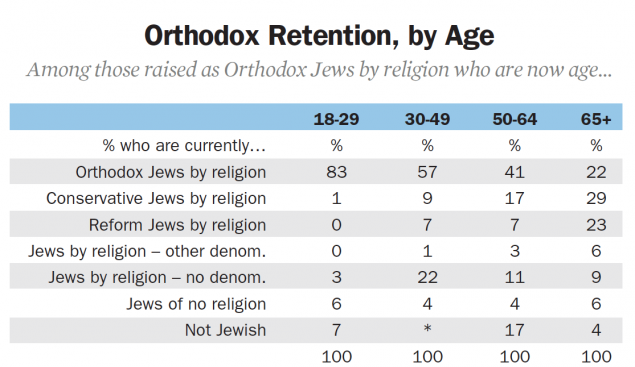
Among those 65 and older who were raised Orthodox, 22% are still Orthodox. In stark contrast, 83% of Jewish adults under 30 raised Orthodox are still Orthodox.
*Figures may not sum to 1oo% due to rounding.
We need to learn more about the American Jewish community at large and ask what we can do to strengthen in-marriage, community building and Jewish education for those who do not share our denominational commitment—precisely because we are the best equipped to do so. We have richer and better Jewish education than the overwhelming majority of American Jews. We have tight-knit synagogues that take prayer, Israel and Jewish identity seriously. We shine at building communities based on chesed and responsibility. We invest in Jewish education on every level. Virtually every aspect of neglect and loss that, not surprisingly, surfaced in the Pew report has not impacted the Orthodox community.
The only thing stopping us is the thickness and opacity of the walls put up between ourselves and the larger American Jewish community. We tend to see ourselves as the inheritors of European Jewish life rather than descendants of a textured American Jewish history. The subject is rarely taught in our day schools. Few Orthodox people even bothered to read the Pew report. Many who did concluded that it was someone else’s problem as opposed to our shared and collective responsibility. We have become so fragmented that the identity hemorrhaging that is currently taking place is regarded as an “I told you so” phenomenon rather than a remarkable opportunity for change and a religious challenge.
Returning to the statistic about Orthodox drop-out rates, perhaps if the Modern Orthodox community engaged in more kiruv to the larger Jewish world that desperately needs what we have in abundance, our own kids would stay within the fold. In the words of one Chassidic rebbe, outreach is like throwing a ball. Sometimes someone else catches your ideas; sometimes they hit a wall. But when they hit a wall, they also bounce back, and you catch them yourself.
At the age of eighteen, Mormon kids devote themselves to two-year missions to engage others. This may or may not work as an outreach tool, but it has a more profound consequence—it strengthens the spiritual life of its ambassadors at a critical time of personal and religious development and decision-making.
Jonah is the only Biblical book to end with a question. It is a question that perhaps God is still asking us. How long will we sit in a sukkah, closed off from others who need us, thinking about our own institutions and their viability and affordability and close our eyes to the larger Jewish world that can benefit from what we have? We can only truly reverse the gloom and doom if we are willing to share our immense blessings and if we regard outreach as an urgent and sacred responsibility.
Dr. Erica Brown is the scholar-in-residence at the Jewish Federation of Greater Washington. Her most recent book is Happier Endings: A Meditation on Life and Death (New York, 2013).
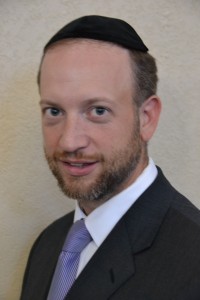 The Pew Report: A Wake-up Call
The Pew Report: A Wake-up Call
By Efrem Goldberg
This past October, two messages vitally important to the Jewish community were delivered in the same week. At the United Nations, Prime Minister Benjamin Netanyahu delivered an impassioned speech and addressed what he described as nothing short of an existential threat to the State of Israel—Iran. Elsewhere, the Pew Research Center reported the results of a survey of American Jews, revealing nothing short of an existential threat facing American Jewry—assimilation. While the solution to the threat posed by a nuclear Iran is neither simple nor easy, it is attainable—preferably through diplomacy or, if not, through military action.
However, one can neither negotiate with, nor drop a bomb on, the devastating statistics and distressing portrait painted by the Pew report. More creative, coordinated and systemic solutions will be needed if we are going to reverse the clear trends that are emerging regarding the state of American Jewry and our future.
Alarmingly, the survey found that among the non-Orthodox, the intermarriage rate is currently at 71 percent. More than one in five American Jews describe themselves as having no religion, 22 percent of American Jews say they never attend religious services and 62 percent report that being Jewish is primarily a matter of ancestry and culture. More than a third of American Jews responded that believing in Jesus as Messiah is compatible with Judaism. Forty-two percent said that they believe having a good sense of humor is part of what it means to be Jewish; 19 percent said observing Jewish law is an essential part of being Jewish.
Much of the analysis and many of the articles about the survey have addressed the revelations regarding the different Jewish denominations. The survey found that “One third (35%) of all U.S. Jews identify with the Reform movement, while 18% identify with Conservative Judaism, 10% with Orthodox Judaism and 6% with a variety of smaller groups, such as the Reconstructionist and Jewish Renewal movements. About three in ten American Jews. . . say they do not identify with any particular Jewish denomination.”
The survey points to the struggles of the liberal movements that are hemorrhaging members—and perhaps relevance—rapidly. It is easy for the Orthodox community to read the survey and react with a sense of triumphalism, but that would be a horrible mistake, for several reasons.
First, it is abundantly clear that the struggle of the other streams of Judaism is not a result of a migration to Orthodoxy. The reality is quite the opposite—those who have left those denominations are leaving Judaism altogether.
I cannot articulate it better than Rav Aharon Lichtenstein, rosh yeshivah of Yeshivat Har Etzion, who wrote in the 1982 spring edition of Tradition:
Nor do I share the glee some feel over the prospective demise of the competition. Surely, we have many sharp differences with Conservative and Reform movements, and these should not be sloughed or blurred. However, we also share many values with them—and this, too, should not be obscured. Their disappearance might strengthen us in some respects, but would unquestionably weaken us in others. And of course, if we transcend our own interests and think of the people currently served by these movements—many of them, both presently and potentially, well beyond our reach or ken—how would they, or Klal Yisrael as a whole, be affected by such a change? Can anyone responsibly state that it is better for a marginal Jew in Dallas or in Dubuque to lose his religious identity altogether, rather than drive to his temple?
Secondly, if the undeniable trend of American Jewry is a shift toward secularism and assimilation, the burden on the traditional community to preserve, sustain and promote authentic Judaism is perhaps greater than ever. We cannot afford to feel triumphant or content when we have a sacred mission and a holy mandate to fulfill.
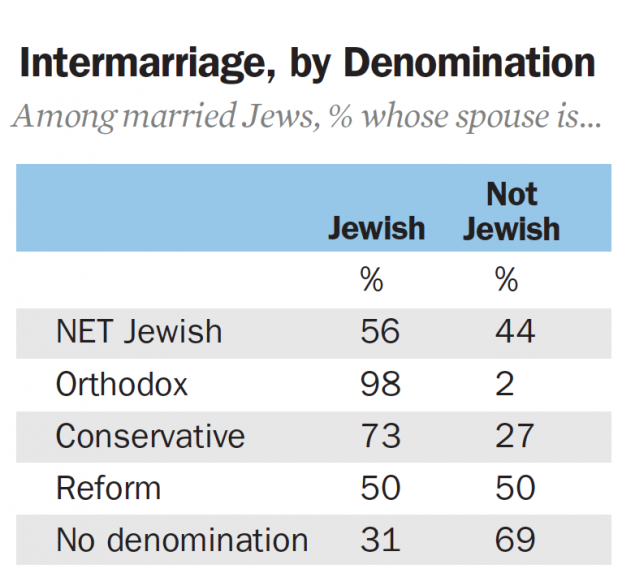
Rates of intermarriage vary considerably among the major US Jewish denominations. Virtually all Orthodox respondents who are married have a Jewish spouse (98%) and most married Conservative Jews have Jewish spouses (73%). Half of Reform Jews who are married have a Jewish spouse. Among married Jews who are not affiliated with any denomination, 31% have a Jewish spouse. *Figures may not sum to 1oo% due to rounding.
Lastly, and most importantly, if you read the survey, you will see that it provides much for the Orthodox community to reflect upon. It found that many who were raised Orthodox no longer affiliate with Orthodoxy. Frankly, we didn’t need the survey to notice that Orthodox communities are struggling mightily to raise inspired Jewish teens and young people. Many Orthodox youth, including those currently enrolled in Orthodox schools, unabashedly admit to eating out nonkosher, texting on Shabbos, not putting on tefillin and to a general disaffection with the observant lifestyle and its rigorous demands. Their attitude is, “if doing these things doesn’t ‘do anything’ for me—and they don’t—why should I observe them?” We must articulate a compelling answer to that question and many of their other questions if we are going to inspire our young people to proudly carry the torch of Orthodox Judaism forward.
If nothing else, this survey indicates that the Jewish American landscape is changing rapidly—and not for the better. America has been a better host country to the Jewish people than any other country in our history. The freedom it provides and the rights it grants us make this the most blessed land in which a Jew can live, outside of Israel. But clearly freedom, liberty and autonomy come with great costs, such as the seductive urge and invitation to assimilate into the greater culture and lifestyle around us.
Avraham Avinu, the founder of ethical monotheism and the father of our people, when purchasing a grave for his wife, described himself as “ger v’toshav anochi imachem, I am a stranger and a resident together with you.”
Rabbi Yosef Dov Soloveitchik, zt”l, explains that in this introduction Avraham captured the tension that every Jew is destined to live with forever. On the one hand, we are toshavim, residents and inhabitants of the great countries in which we live. We function as active citizens, participating in the fullness of the society around us. And yet, at the same time, we must remain geirim, strangers: different, apart, distinct and dissimilar. Ger v’toshav—we are to simultaneously be part of, and apart from, the general world around us. Striking the proper balance and equilibrium between our dual identities and roles is the mission of the Jew at every time and in every place that he or she has ever lived.
There have been periods in our history in which we didn’t need to work hard to remember that we are different. Through anti-Semitism, persecution and oppression, our hosts have often reminded us that we are geirim, we are not the same. As much as we tried to blend in and assimilate, we were denied the opportunity to be toshavim, equal residents and citizens. Indeed, the imbalance which tilted toward being geirim, toward being different, was our default status for the bulk of our history, particularly in exile.
And yet, at this moment in history, while we are blessed to live in this great country, a truly exceptional place that has afforded us extraordinary opportunity, once again our balance is off, our equilibrium between ger v’toshav, stranger and resident, is out of alignment—this time in the opposite direction.
We cannot focus all of our efforts on outreach, inviting Jews in through the front door, while our own children are sneaking out the back.
The Pew report is a sobering wake-up call, a harsh and stark reminder that if we succumb to the allure of finally being toshavim, finally being fully accepted and integrated residents, we stand to lose our identity as geirim, as Jews, and we will find ourselves fully assimilated, believing that having a good sense of humor is a meaningful part of being Jewish.
The truth is that the trend toward secularism and universalism is not uniquely Jewish. While elsewhere in the world sectarian groups are at war to protect what makes them different and distinct, the movement in America seems to blur and erase boundaries and differences altogether. The implicit message communicated in popular culture and often articulately taught on college campuses across the country is that we are all the same. The force of universalism is pervasive in this country, and the results of the Pew report make it clear that it has penetrated into all segments of the Jewish community, including the Orthodox.
Exploring the topics of Jewish exceptionalism, what it means to be a Jew and why being a ger, being different, matters, is clearly a necessary component of the solution to this existential threat. Should we, like Noach, retreat to insular arks and protect ourselves and our families? Should we create isolationist communities shielded from the foreign influences of the secular world? Or perhaps we should spread our wings further and deeper into the general American culture and try to bring our ancient and timely wisdom to the world around us?
The Pew report yields two clear conclusions and mandates for our Orthodox community. First, we must focus our energies and resources on outreach, recognizing that it is up to us to plug the dam that has turned from a slow leak into a full-fledged flood of intermarriage and assimilation. Kiruv must not be the domain of rabbis and outreach professionals alone. If we are to move the needle on these statistics, we will need to make outreach a communal imperative and mandate incumbent on every Orthodox individual and family.
The great economist Milton Friedman taught that if you want to know the values and ideals of a company or organization, don’t listen to what they preach but examine their budget and see how they allocate their funds. Will the call for “someone” to do kiruv remain lip service alone, or are our shuls prepared to put a line item for outreach in their budgets, with specific and adequate allocations for staff, programs and follow up? Will outreach be relegated to ancillary organizations and individuals, or are we willing to change the culture in mainstream Orthodox shuls to be more welcoming, warm and open to the uninitiated? Would a stranger who wanders into our shuls be greeted warmly, find a yarmulke easily and have the page numbers announced or displayed regularly? Or will he feel lost, unwelcome and too intimidated to stay or return in the future?
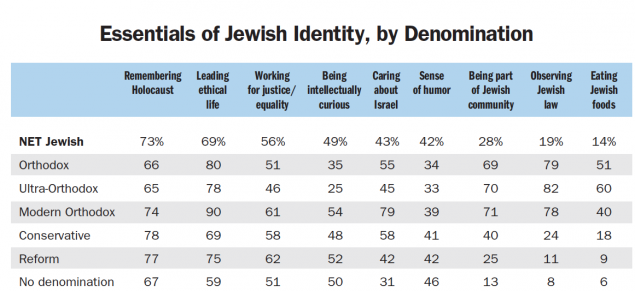
Roughly seven-in-ten US Jews (73%) say that remembering the Holocaust is an essential part of what being Jewish means to them. Nearly as many say leading an ethical life is essential to what it means to be Jewish (69%).
Eight-in-ten Orthodox Jews (79%) say observing Jewish law is essential to what being Jewish means to them. This view is shared by just 24% of Conservative Jews, 11% of Reform Jews and 8% of Jews with no denominational affiliation.
At the Boca Raton Synagogue (BRS) in Florida, we are incredibly proud to have a dedicated outreach rabbi as part of our rabbinic leadership team. Rabbi Joshua Broide brings limitless energy and passion to working with the unaffiliated, but he relies on our members to make introductions and referrals. Through sermons, classes, our literature, our web site and our budget, our members understand that reaching out to the 120,000 Jews in the Boca Raton area is a core value and responsibility for our BRS community. They are constantly reminded that to make a dent in the 92 percent assimilation rate in our area, they will need to get involved in reaching out to a coworker, neighbor or friend and invite them to a beginner’s program or class or, most meaningfully, to their homes.
Twice a year BRS runs S.O.S.—Share One Shabbos—asking all of our members to invite someone who has never experienced an authentic Shabbos meal into their homes, the most authentic and effective venue for inspiring an inexperienced Jew. If they can’t think of someone to invite, we are happy to provide them with guests. Hundreds of families have participated and the results have been outstanding. Through personal follow up, some have become observant and moved into our neighborhood. Many have taken further classes or started attending Rabbi Broide’s Friday Night Live program. Most, at least, had a positive experience with encountering Orthodoxy up close and tasting what Shabbos is all about.
Many mistakenly assume that rabbis, rebbetzins and educators are best positioned to succeed at outreach. While we may have more technical knowledge and be more comfortable in the role of teacher, we cannot compare with the power of a genuine and sincere relationship between an “ordinary” Orthodox Jew and someone Jewishly inexperienced. Don’t be hesitant or afraid. The Orthodox community could easily touch the lives of tens of thousands of secular Jews every year if we simply make it a priority and recruit all of our members to get involved.
The second mandate that emerges from the Pew report is the need to focus our efforts on retention by revisiting how we interact with, educate and inspire our youth. We cannot focus all of our efforts on outreach, inviting Jews in through the front door, while our own children are sneaking out the back. The observance of and compliance with an Orthodox lifestyle that we took for granted with our children in the past are no longer a given, and we need to think creatively of ways to model and inspire passion within those who represent our future.
Let us pray that with our renewed efforts coupled with siyata d’Shmaya, Divine assistance, a Pew survey a decade from now will report a thriving, flourishing Jewish people steeped in Jewish values and Torah.
Rabbi Efrem Goldberg is the senior rabbi of the Boca Raton Synagogue, an OU shul in Boca Raton, Florida.
![j schacter photo[1]](http://jewishaction.oudev.org/content/uploads/j-schacter-photo1-300x251.jpg) The Pew Report: It Really Matters
The Pew Report: It Really Matters
By Jacob J. Schacter
Many words have been spoken and much ink has been spilled about the Pew report. This report—both in general and with regard to many of its specific points—has been dissected, discussed, debated, examined, analyzed and questioned. And, from my perspective, two points are clear.
One, it matters. It is not about yenem, someone else. It is about us, our people. The Orthodox community needs to pay close attention to the findings. The Orthodox community in the United States needs to pay more attention—serious attention—to what this report presents about American Jewry, our Jewry.
Second, I see this report as an indictment of Orthodoxy. Yes, our intermarriage rates are very low (2 percent); the median age of those who identify as Orthodox is the lowest (40, compared to the median age in the net Jewish population, 50); our fertility rates are the highest (4.1, more than double the overall Jewish average of 1.9); our retention rate in the 18- to 64-year-old categories is the highest, and there are other signs of our significant success. However, it graphically highlights just how much we have failed to meaningfully engage and impact the broad spectrum of acheinu Bnei Yisrael in this country.
But first, as always, a Torah thought.
All aspects of the mishkan are described in great detail in the second half of Sefer Shemot—not only once, but twice. The text focuses on the structure of the mishkan, its vessels and the garments worn by the priests who ministered within it. The Torah describes, in great detail, the curtains, the beams and the pillars, the ark, the altars, the menorah and more. But there is one very small segment of the mishkan’s structure, often ignored and overlooked, that is highlighted by an interesting Midrashic passage on a verse at the beginning of Parashat Pekudei.
The midrash (Yalkut Shimoni, Pekudei #415) relates that after the work of the mishkan was completed, Moshe invited the Jewish people to make an accounting. “Thousands of shekels were collected and thousands of shekels were spent,” he said. “Let us make sure that all the money was allocated appropriately and that both sides of the ledger match with one another.” All the Jews gathered around, continues the midrash, Moshe commenced the audit and, lo and behold, when he was finished, he was 1,775 shekels short. The money was raised but he could not account for how it had been spent. He began to panic and was afraid that his honesty would be suspect and that his integrity would be impugned. He even expressed the fear that the Jews would accuse him of embezzling the funds! Once again Moshe feverishly scanned the entire structure of the mishkan, searching for something he might have missed. Finally, God “enlightened” him and drew his attention to the tiny little hooks that held the mishkan’s pillars together, the “vavin la’amudim.” Here he found the objects for which he had spent that money (Shemot 38:28). At that moment, concludes the midrash, the Jewish people were appeased and the potential problem was averted.
Why is the midrash drawing our attention to these tiny hooks or links or hinges? It would appear that it is trying to highlight the hooks or the links or the hinges, sometimes tiny and sometimes easily overlooked, that connect either pillars to one another or, I would suggest, Jews to one another. In Hebrew, the letter “vav” means “and,” linking two objects or people together. The Midrash, I believe, teaches us the power of the vav, the connections. It is never about us as individuals; it is always about “us and,” in ever-larger concentric circles—us and our families, us and our communities, us and the Jewish people, us and the larger world in which we live and us and the Ribbono shel Olam.
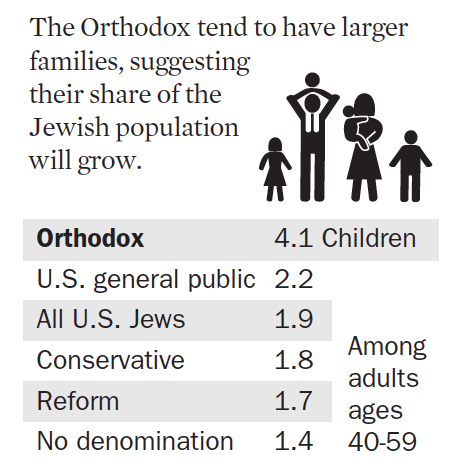
The average number of children born to Orthodox Jews (4.1) is about twice the overall Jewish average (1.9).
The Rema in Yoreh Deah (273:6) notes that there is a hiddur for every column (amud) of a sefer Torah to begin with the letter vav, and he refers to this by a name with which we are now familiar, vavin la’amudim. Every new column of our lives, every pillar of our existence, needs to be animated by the lesson of the letter vav.
Furthermore, the Torah tells us that after Cain killed Abel, “And God appointed a sign (ot) for Cain” (Bereishit 4:15), colloquially referred to as “the mark of Cain.” What, exactly, was the mark of Cain? The Midrash informs us that it was not simply a random mark but it was, literally, an ot, a letter, and it refers to the Hebrew letter “vav.” Why this letter, of all possibilities? The late Rabbi Meir Shapiro, the Lubliner Rav, one of the greatest scholars and communal leaders of the twentieth century, explained that Cain, the person who was only concerned about himself and who could have the temerity to say to God, “Am I my brother’s keeper?” (Bereishit 4:9) had to be taught for the rest of his life the lesson of the letter “vav.” Emblazoned on his forehead for all eternity is a reminder that it is him and. His concerns had to transcend only himself; he needed to see himself as linked to others. Indeed, he was his brother’s keeper.
And, finally, on what day was Adam created? He was created on “yom vav,” not to be understood only as “the sixth day” but, perhaps more profoundly, as “and day.” Already at the dawn of creation, the first human being ever created was taught that as the universe will unfold with him at its center, it will never be about him alone; it will always be about him and. Indeed, in a real sense, all of us Jews must consider ourselves as bound by the lesson of the letter “vav,” each one of us standing not alone but committed to “me and,” not only to ourselves but also to those who exist beyond and separate from us.
The growing insularity of American Orthodoxy is a tragedy because we carry on as if we are all who matter.
Those wonderful hooks or connectors that held together the structure of the mishkan represent the connectors that need to hold together all Jews. What happens to Jews across America matters to us because we are connected to them. We are one people. The growing insularity of American Orthodoxy is a tragedy because we carry on as if we are all who matter. I was deeply upset and saddened to hear that one of the prominent members of our community stated publicly on various occasions that the Pew report is not all that alarming because committed Jews were, historically, always a minority and that this report simply describes the most current iteration of that phenomenon. While this may be historically true, it dare not absolve us of the responsibility to do what we can to raise the level of engagement of other Jews with Judaism, one by one by one. This effort needs to be included in the list of the current priorities of the contemporary Orthodox community.
The picture painted in this report is not a pretty one. One-in-five American Jews describe themselves as having “no religion”; among Jews who were married since 2000, nearly 60 percent are intermarried; only 31 percent of American Jews are members of a synagogue—any synagogue!; only 26 percent of American Jews say that religion is very important in their lives (compared with 50 percent of Americans in general) and there is more. And all this happened as Orthodoxy was, thank God, growing in numbers and intensity. The good news is that many of our synagogues are filled with shomrei Shabbat Jews, and the bad news is that many of our synagogues are filled with shomrei Shabbat Jews. Where are the non-shomrei Shabbat Jews going on Shabbat morning? What are we doing to make them feel comfortable in our shuls? Yes, our batei midrash boast shelves full of the latest Machon Yerushalayim Minchat Chinuch, Mosad HaRav Kook’s Torat Chaim Chumash, Mishnah Berurah Menukad, Tur veShulchan Aruch HaBahir, the Metivta U’Velechtecha BaDerech Talmud Bavli HaMevo’ar (Mahadurat Zichron Moshe) and the Talman Shas. And this, indeed, is wonderful (if they are being used). But where is the “yarmulke box” or the “doily box” in our lobbies? We simply have failed to demonstrate the beauty, meaning and warmth of Judaism not only to one in six of our children in the 18 to 29 age category who are not religious (one of the findings of this survey), but to millions and millions of Jews across the country. The reason is not because our “product” is faulty; it is because we have not made this a priority. Shame on us that this disaster is taking place under our own noses. We, partially, need to bear some of the responsibility.
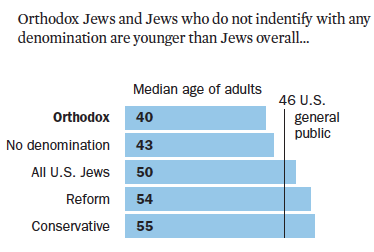
Orthodox Jews (median age of 40) are substantially younger than Conservative Jews (55) and Reform Jews (54).
I have a number of practical suggestions we should be considering, each one worthy of significant attention. We should be placing more JLIC couples on campuses (the Orthodox Union, in partnership with Hillel, administers the Heshe and Harriet Seif Jewish Learning Initiative on Campus [JLIC], a program that helps Orthodox students navigate the college environment), and we should be establishing (once again) afternoon Hebrew schools in our shuls for those children in our broader communities who are not attending a day school. And here’s a simple suggestion that wouldn’t cost much: The OU should spearhead an effort to arrange for all of its constituent synagogues (100 percent participation) to urge all their members (100 percent participation) to devote one Friday night in the next six months to invite nonaffiliated family members, neighbors, business associates or others to their homes for a Friday night Shabbat seudah. Educators should be commissioned to prepare a simple “how-to guide” to Friday night in the home with talking points on how to present Kiddush and lechem mishneh, how to explain the meaning of various zemirot, why bentching consists of multiple paragraphs and themes and more. And, I venture to add, no one will be surprised when it will soon become clear that our families themselves will benefit so much from this more mindful Shabbat experience.
With the lesson of the vav, and with the letter vav at the top of the amud of our communal priorities, we will have a chance to change the face—even if only slightly— of the American Jewish community—our community. The need is urgent. The time is now.
Rabbi Dr. Jacob J. Schacter is university professor of Jewish history and Jewish thought and senior scholar at the Center for the Jewish Future, Yeshiva University. He is a contributing editor to Jewish Action.
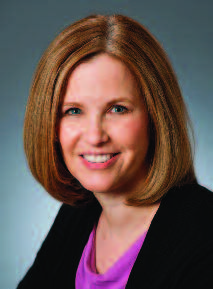 Safeguarding Our Vertical Mesorah in an Increasingly Horizontal World
Safeguarding Our Vertical Mesorah in an Increasingly Horizontal World
By Daphna Raskas
The unbroken historical chain from Sinai to the present day is described in the beginning of Pirkei Avot: “Moshe received the Torah and handed it down to Joshua; Joshua to the Elders; the Elders to the Prophets; and the Prophets handed it down to the Men of the Great Assembly.” Similarly, Maimonides, in his introduction to the Mishneh Torah, provides a generation by generation account of the names of all those in the direct line who transmitted this tradition beginning with Moshe Rabbeinu up until Ravina and Rav Ashi, the rabbis who compiled the Babylonian Talmud. Clearly, the mesorah, the transmission of the religious tradition, has been passed down vertically from generation to generation within the Jewish people. The mesorah assumes this method of vertical transference of the Torah from parent to child, within families and across generations since the time of Moshe.
And yet, as Orthodox Jews in the Information Age, we live in an increasingly horizontally connected world that threatens to disrupt the vertical transference of Torah and the centrality of Torah in our lives. How do we ensure the vertical transference of the mesorah in a world in which our kids are so connected to the outside world 24/6? Witness what occurs the moment Shabbat is over in most Orthodox households. How many members, from the very youngest to the oldest, are checking e-mail or otherwise engaged online?
The Zionist philosopher Ahad Ha’am once famously observed that “More than the Jews have kept the Shabbat, the Shabbat has kept the Jews.”
Not so long ago, parents could contain the external influences in their children’s lives by deciding which schools and camps they attended, which television shows and movies (if any) they were exposed to and by giving them a curfew. The only way kids could engage with the outside world when at home was by means of a telephone that was attached to a wall. Today our children have unlimited and constant interactive exposure to the outside world in the palms of their hands, with their iPhones and iPods. They do not need to leave home to engage with the outside world. True, we can put parental controls and limit the use of the Internet, but there is no mistaking the fact that they and their friends are exposed to the outside world in a multitude of ways that is virtually beyond our control once we allow computers into our homes. The centrality of the home is competing for attention with the outside world in ways that we have never encountered before. All of this has implications for the vertical transmission of the mesorah. In a world where everyone is so busily connected horizontally with the external world, how can we ensure that the vertical transmission of the mesorah continues uninterrupted and with the same steadfastness as it has for thousands of years? Vertical transmission depends on the idea that one is willing to be a follower of something or someone. For thousands of years, the Jews have kept the mesorah, observing halachah by accepting and following the chain of command which began with Moshe and the God-given Torah.
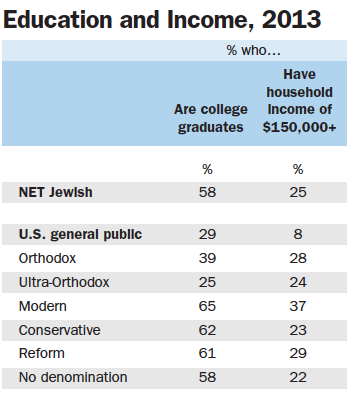
Upwards of one-fifth of all Jews from all of the major denominations say they have household incomes of $150,000 or more.
Today, increasingly, people have moved away from vertical chains of command in business, sociology, as well as in their avoidance of religion. Management experts now speak of horizontal leadership based on trust, a move away from top-down vertical leadership based on command and control. Sociologists speak of an increase in horizontal identity formation with peer groups based on common interests and how these connections compete with vertically formed identities. Americans as a whole are increasingly avoiding religious affiliations. Part of this appears to stem from a move away from accepting the vertical transference that characterizes religion. Americans no longer simply accept the beliefs or causes of their parents and ancestors. Instead, they appear to be increasingly invested in peer groups with whom they share other interests.
The Pew report indicates that one in five individuals who identify as Jews describe themselves as having no religion. This is about 1.2 million Americans and it represents 0.5 percent of US adults. Moreover, 62 percent of American Jews say being Jewish is mainly a matter of ancestry and culture and not religion. Clearly, for the majority of American Jews, the mesorah, the vertical transference of Jewish religious tradition, holds little value. Only 19 percent of Jewish adults surveyed said that observing Jewish law is essential to what being Jewish means to them.
While the “good news” for the Orthodox community is that the falloff from Orthodoxy appears to be declining and is now only 17 percent among 18 to 29-year-olds, this means that we are still losing almost 1 in 6 individuals in this age group who came from homes where the transference of the mesorah was presumably a high priority.
So how do we ensure the continued vertical transference of the mesorah while living in our modern horizontally oriented world? The way we always have—by placing a strong emphasis on Shabbat observance and continuing our strong tradition of Torah learning. The Zionist philosopher Ahad Ha’am once famously observed that “More than the Jews have kept the Shabbat, the Shabbat has kept the Jews.” Never has the expression seemed more accurate than in the Information Age. Shabbat forces us to disconnect from the Internet and the outside world and provides us a twenty-five-hour respite in which to reconnect weekly, uninterrupted, with one another, with our community, with our mesorah and with our Maker.
Traditional Torah learning—either shiurim or chavruta learning—strengthens our communal connections as well. Our religious learning can and should be enhanced by the worldwide web during the week and yet still remain in its original form, steeped in text. Nicholas Carr, in his book The Shallows, asserts that printed books focus our attention and promote deep and creative thought while the Internet encourages rapid, distracted sampling of many small bits of information. We have become more adept at scanning and skimming, but, according to Carr, we are losing our capacity for concentration and reflection. Traditional Torah learning on Shabbat and during the week not only helps us preserve cognitive skills, it helps us preserve the vertical transmission of the mesorah in the manner of our fathers.
If we continue to emphasize the importance of observing Shabbat and studying Jewish texts, we will hopefully maintain the transference of the mesorah even in these times. If we wish to go one step further and strengthen the transference of the mesorah so that the next Pew survey yields more encouraging results regarding the future of American Jewry, we need to prioritize extending ourselves outside of the American Orthodox community to warmly encourage other Jews to join us in these fundamental mitzvot.
Dr. Daphna Raskas is a consultant to nonprofit organizations in the Greater Washington area.
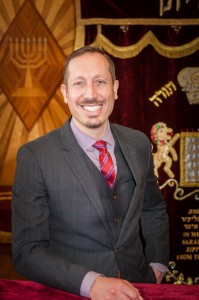 Reclaiming the Disappearing Center
Reclaiming the Disappearing Center
By Daniel Friedman
Conservative Judaism has long prided itself on being the happy medium between Orthodox and Reform Judaism. The recent Pew report has shown, however, that save for a few committed souls, much of its traditional base has drifted away. In a world of increasing secularization, many former adherents are no longer comfortable with the Conservative appellation and have opted instead to identify with the Reform camp— synagogue affiliation notwithstanding.
Over the years, the response of Conservative Judaism to its declining appeal has been to push the halachic envelope further and further. While there was a time in America when a Conservative synagogue and service were quite indistinguishable from many an Orthodox synagogue and service, the introduction of unprecedented innovations such as egalitarianism and same-sex marriage has undoubtedly widened the chasm between Orthodox and Conservative Judaism.
And yet, not all within the Conservative camp have welcomed these innovations with open arms. When Conservative Judaism began ordaining women, a number of members broke with the movement and began the Union for Traditional Judaism (UTJ). And when the question of same-sex marriage arose, a number of synagogues seceded from the United Synagogue of Conservative Judaism.
It is time for us to open our arms to our traditional coreligionists. Many are yearning for a place back within the classical fold and it is our duty to figure out how to open our doors to these sincere souls and congregations who yearn to be part of the mesorah that has kept our nation strong for three millennia.
Many of those on the right of Conservative Judaism hold less radical views than those on the left of Orthodoxy.
Long before the days of polarized Judaism, there was a time when it was par for the course to work with Conservative congregations with the hope that they would become normalized to Orthodox practice. There are many such stories, where Orthodox rabbis entered Conservative congregations with the blessings of their teachers and institutions. Certainly not every such story culminated in success, but for some reason Orthodoxy has long since shied away from the challenge.
And in addition to the congregations, there are certainly many rabbis ordained by the Conservative movement who would welcome the opportunity to be acknowledged by their Orthodox counterparts. These individuals feel lost in a movement which they sense has forsaken them as it slowly but surely cedes traditional practice to the will of the people. And while their voices are falling on deaf ears in the Conservative movement, they would be a welcome addition to the honest halachic debate that prevails in Orthodoxy. In fact, many of those on the right of Conservative Judaism hold less radical views than those on the left of Orthodoxy. The Metivta of UTJ does not ordain women, nor does the Canadian Yeshiva & Rabbinical School. While it goes without saying that this regularization process would entail confirmation of their halachic and hashkafic knowledge and commitment, are we having the conversation?
The Orthodox community dare not be smug about the latest report on the state of American Jewry. The Pew report is only as useful as our response to it. Our responsibility extends to all our brothers and sisters. In a world of alarming assimilation rates, let us join forces with those who believe in what we believe and strive for what we strive for.
Rabbi Daniel Friedman is rabbi of Beth Israel Synagogue in Edmonton, Canada, an OU shul.
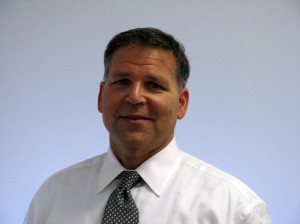 Lessons from Pew
Lessons from Pew
By Jerry Silverman
In the months since the Pew report was released, our community has debated its significance and how we should respond. The survey continues to produce a wide range of provocative proposals and views, making me deeply optimistic that we not only have the will, but the means, to address the survey’s challenges.
One key finding is that younger non-Orthodox Jews are less connected to Jewish life and less interested in engaging. The numbers alone add up to an existential crisis facing the nonreligious community. The Orthodox community faces a slightly different but no less daunting challenge—the fact is that some of its members are leaving. I am deeply concerned that the spiraling costs of living a Jewish life and educating our children Jewishly will only increase this migration further.
These challenges compel us to unite as a community and consider creative new strategies. We also need to face the fact that such approaches may require new funding. I believe that when we come together as a community, our potential remains unlimited.
Recently, Michael Siegal, chair of the Board of Trustees of the Jewish Federations of North America, and I proposed four areas where we should intensify our focus in order to help connect younger Jews to the community.
First, free Jewish early childhood education for every family. Based on the success of programs like PJ Library, a Jewish Head Start could bring many more Jewish families along the path to involvement.
Second, we cannot ignore Jewish camp as a particularly effective engagement channel. Research shows three things: Jewish camp, day school and Israel experience programs engage young Jews. We should triple the number of non-Orthodox kids in Jewish camps to 30 percent of the population.
Next, Birthright Israel stands out as a highly effective Jewish engagement program, bringing more than 350,000 young Jews to Eretz Yisrael and imbuing them with a new sense of Yiddishkeit. However, we have not consistently and effectively re-engaged with Birthright alumni. Birthright has compiled an incredible database of past participants, but other institutions need access to the information to better connect with these newly inspired young Jews.
The Orthodox community claims an 83 percent retention rate–but that still means a large number of Orthodox Jews are opting out. It’s time we look seriously at the high cost of Jewish life as a significant factor.
Finally, we must focus our thinking on areas in our country where our population is concentrated yet, ironically, suffers more tenuous ties to Jewish life. We need to consider these areas as “Jewish Development Zones” and redouble existing successful programs like those we outlined above to better engage the unaffiliated.
In addition to these four proposals, the Government of Israel recently launched its World Jewry Initiative, which takes a bold new approach. The initiative seeks to build Jewish identity in the Diaspora, because ultimately, a stronger Diaspora means a stronger Jewish State.
These plans contend with the larger challenge of the non-Orthodox community in the US and elsewhere, but we also face a serious challenge in the religious community. Yes, according to the Pew survey, the Orthodox community claims an 83 percent retention rate—but that still means a large number of Orthodox Jews are opting out. It’s time we look seriously at the high cost of Jewish life as a significant factor. When Orthodox day schools cost $20,000 to $35,000 a year, not to mention the price of annual synagogue membership and camp fees, you have to consider how this is affecting young couples and families.
Formal Jewish education is a beautiful privilege. My wife and I sent our five children to Jewish day schools. However, we also need to conceive of more experiential Jewish learning, to ensure that young Jews who may not have the opportunity to attend formal Jewish schools still enjoy the beauty of Jewish life. Informal and innovative programs, camps and other initiatives could significantly increase the variety of experiences available to young Jews.
Across our community we have built great institutions and developed highly effective programs that address many needs. Now it’s time that we come together as a more united community, to take a holistic look at the bigger picture which Pew has presented. The survey, in a way, is a gift—a major opportunity to take a new look at some of the most effective tools we’ve developed and to use them in daring new ways. We must unite around a shared sense of mutual responsibility, of kol Yisrael arevim zeh lah zeh. We may not agree on every question, or on any one answer, but there is no doubt that by coming together, by uniting as one people and working toward a common goal, we can build a more secure and vibrant tomorrow, for our entire community.
Jerry Silverman is president and chief executive officer of the Jewish Federations of North America.

